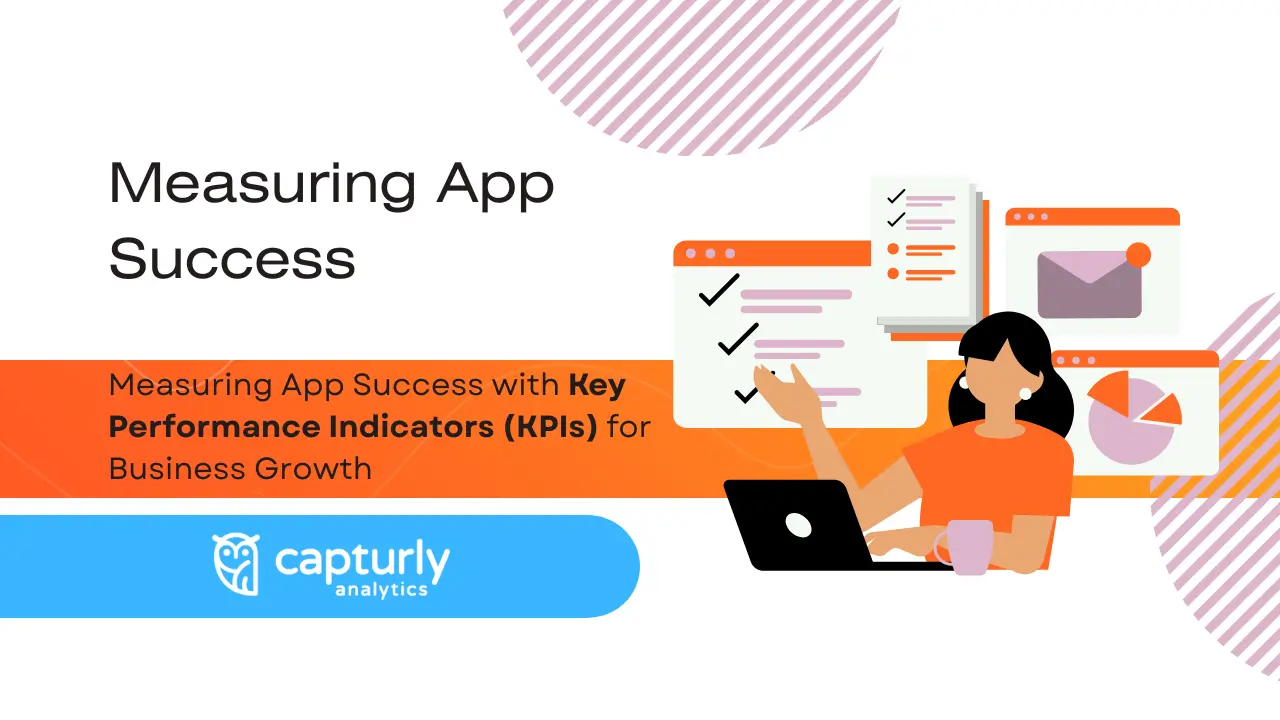Developing a mobile application is a significant accomplishment. However, your work does not end once the software is launched. Are there any key performance indicators to track quality and performance? There are, indeed. Only by measuring mobile app analytics and mobile app KPIs can these issues be answered.
Key performance indicators will show you exactly what you’re doing properly and where you need to improve. Everyone, regardless of app type or sector, should be tracking the KPIs listed below. This blog post discusses a few key performance indicators (KPIs) that you may use to assess the quality and growth of your apps. You can do this on your own or with the assistance of a professional mobile app development business that is well-versed in KPIs.
Table of Contents
KPIs for mobile apps: An Overview
Mobile apps are critical to corporate growth in today’s society. Mobile apps are a great method to communicate with customers, increase engagement, and generate income. Having an app, though, is only the beginning.
KPIs are a set of measurable metrics that allow organizations to track and measure the performance of their app. The actual challenge is tracking and measuring the app’s success. Businesses may identify areas for development, optimize performance, and ultimately increase user engagement by creating and analyzing KPIs. The KPIs are also dependent on the app development process flowchart, which serves as the foundation for all types of app development.
What makes selecting the right KPIs so important?
Selecting the right Key Performance Indicators (KPIs) is crucial for several reasons:
Alignment with business objectives
KPIs should be directly linked to the organization’s strategic goals and objectives. By selecting the right KPIs, businesses can ensure that their efforts and resources are focused on measuring and improving the factors that truly matter for success. Aligning KPIs with business objectives enables effective monitoring of progress and facilitates informed decision-making.
Measuring relevant metrics
Choosing the right KPIs allows businesses to measure the most relevant metrics that reflect performance and progress in key areas. Each organization has unique priorities and areas of focus, so it is essential to select KPIs that capture the critical aspects of performance specific to the business. By measuring the right metrics, organizations can gain meaningful insights and make data-driven decisions.
Performance evaluation and benchmarking
KPIs serve as benchmarks for evaluating performance over time. They provide a quantifiable measure of progress and enable businesses to assess their performance against predetermined targets or industry standards. By selecting appropriate KPIs, organizations can track their performance, identify areas for improvement, and compare themselves to competitors or best practices in the industry.
Focus and prioritization
Having a concise set of well-defined KPIs helps organizations focus their efforts and resources on the most important aspects of their business. It enables clarity and prioritization, ensuring that employees and teams are aligned and working towards common goals. By selecting the right KPIs, businesses can avoid information overload and concentrate on the metrics that truly drive success.
Early identification of issues
Effective KPIs provide early warning signs of potential issues or deviations from desired outcomes. By regularly monitoring and analyzing KPIs, businesses can detect performance gaps or negative trends early on, allowing for timely corrective actions. This proactive approach helps prevent larger problems and enables organizations to make adjustments and optimize their strategies to achieve desired outcomes.
Communication and accountability
KPIs serve as a means of communication within an organization. By selecting and clearly defining KPIs, businesses can ensure that everyone understands what is being measured and why it is important. Well-defined KPIs also promote accountability, as individuals and teams can be held responsible for their contributions toward achieving the desired outcomes.
Growth-Driven KPIs : The Three Categories
When it comes to measuring growth and success, there are three main categories of Key Performance Indicators (KPIs) that are often used in a growth-driven approach:
Acquisition KPIs
These KPIs focus on measuring the effectiveness of your app’s user acquisition efforts. They provide insights into the number of users who discover and download your app.
Some commonly used acquisition KPIs include:
- App Downloads: The total number of times your app has been downloaded by users.
- Cost per Acquisition (CPA): The average cost associated with acquiring each new user.
- Conversion Rate: The percentage of app visitors who become users or customers.
- Channel-Specific Metrics: Metrics that measure acquisition performance for different marketing channels, such as organic search, paid advertising, social media, or referral programs.
Activation and Engagement KPIs
These KPIs focus on measuring user engagement and the effectiveness of your app in delivering value to users. They help you understand how well your app is performing in terms of user onboarding, retention, and overall engagement.
Some key activation and engagement KPIs include:
- Daily, Weekly, or Monthly Active Users (DAU, WAU, MAU): The number of unique users who actively use your app within a specific time frame.
- Session Duration: The average amount of time users spend in each app session.
- Screens per Session: The number of screens or features users interact with during a single session.
- Retention Rate: The percentage of users who continue to use your app over a specific period of time.
Revenue and Monetization KPIs
These KPIs focus on measuring the financial performance and revenue generation of your app. They help you understand the effectiveness of your monetization strategies and the overall profitability of your app.
Some common revenue and monetization KPIs include:
- Average Revenue per User (ARPU): The average amount of money made per user.
- Conversion Rate: The percentage of users who make in-app purchases or subscribe to premium features.
- Lifetime Value (LTV): The predicted revenue that a user generates over their entire lifetime as a customer.
- Ad Revenue: The income generated from displaying advertisements within your app.
Measure your mobile app’s growth and success with these top 10 KPIs
Here are the top 10 key performance indicators (KPIs) which greatly contribute to a quality application, and are used for measuring app success. Let’s get started measuring app quality with the metrics listed below.
Application Downloads
One of the most crucial mobile app KPIs to monitor is downloads. It’s one of the simplest ways to determine whether or not your mobile app marketing efforts are effective.
If your app isn’t being downloaded, there are probably additional problems with your marketing funnel. If you didn’t market your app before launch, don’t expect a large number of downloads on day one.
As a result, you should set realistic expectations for this measure and avoid comparing your download metrics to those of Facebook or Twitter. It’s critical to monitor your downloads over time to see how this app measures changes in your marketing efforts.
Rate of Retention
People must do more than simply install your app on their devices for it to be genuinely successful. That is why the retention rate is so critical. User retention measures how many users return to your app after their initial session.
As a result, you must make efforts during these critical hours to guarantee that users have a pleasant experience. Make sure you’re providing customers a cause to open the app again and return in the long run.
It is in your best interests to track user retention on a daily, weekly, and monthly basis. This might assist you in determining whether the measure is linked to specific known issues in the program, such as crashes or downtime. Optimizing the user experience is the key to success with high retention. A great UX/UI design contributes significantly to excellent retention.
Users who are present
Active consumers boost downloads and retention to the next level. This key performance indicator measures the number of individuals who use the app. This metric can be divided into two categories: daily active users and monthly active users.
The number of daily active users is an important indicator of engagement. What draws consumers to your app daily? The number of monthly active users is also an essential metric. People in this category may use your app many times each week, they just don’t use it every day.
Stickiness Ratio of Mobile Apps
Using a daily active user number divided by a monthly active user number, the stickiness ratio is calculated. This KPI shows your chances of obtaining an MAU who will later become a DAU.
Using push notifications and regularly upgrading your app are two strategies to increase the stickiness of your app. You simply need to find ways to persuade your current users to use the app more frequently.
App Store review
Your app store rating is a quick and simple approach to finding out what existing consumers think of your app. This metric might be an important element of your mobile app marketing strategy if your rating is high.
This measure is significant since it may be directly linked to your app downloads. Most consumers will not consider installing an app unless it has four or five stars. Giving existing users an incentive to rate your app is one strategy to increase your rating. Most people will not go out of their way to do this unless they had an extremely positive or negative experience and the average user usually falls somewhere in the middle.
App Store purchases
In-app purchases are quite self-explanatory. It’s a number that displays how frequently people spend actual money on your app. To track a metric like this, you must have purchases and app monetization enabled.
However, it is critical to analyze this quantity over time to determine whether certain events or campaigns result in increased transactions. For example, during the holiday season, in-app purchases for e-commerce apps may surge. Perhaps you have a gaming app that noticed a boost in sales after a specific marketing offer went live.
Churn rate for mobile apps
The churn rate tracks the percentage of people who abandon your app entirely. Not all churning users are made equal. It is far worse to lose low-value users than it is to lose daily users who are highly engaged. If your app’s high-value users are leaving, it’s an indication of a far deeper problem that has to be addressed right away.
App Store positioning
Your app store rating represents your position on app shops for a specific search query. The better your position, the more likely it is that users will see and download your app. Understanding the basics of app store optimization and knowing what to put on your app store page are two simple strategies to climb the rankings.
Rates of abandonment
The abandonment rate is frequently mistaken for the retention rate and the churn rate. However, this mobile app’s KPI is a little different. This number measures how many users abandon your app before signing up.
So someone went to the bother of downloading and opening your app but never completed the signup procedure. A high rate of user abandonment is usually indicative of a poor onboarding process. Perhaps you’re asking for too much information or making it difficult for users to sign up.
Don’t forget about your website!
Ensuring the success of your digital platforms involves not only focusing on your app but also giving due attention to your website. If these two coexist in your digital ecosystem, then they should both be nurtured and optimized equally to drive user engagement and business growth.
There are several key performance indicators (KPIs) on your website that should never be overlooked. Primarily, the bounce rate and conversion rates offer invaluable insights into user behavior. The bounce rate provides an understanding of the users who navigate away from your website after viewing only one page.
A high bounce rate could indicate a disconnect between what your site promises and what it delivers. Meanwhile, the conversion rate gives you a direct measure of how effective your site is at encouraging visitors to complete a desired action, be it making a purchase, signing up for a newsletter, or downloading a resource.
Beyond these metrics, an in-depth analysis of your visitors’ behavior is of paramount importance. By understanding their interactions with your site, you can unearth critical insights that can guide your site’s optimization. Visitor behavior analysis uncovers their navigation patterns, highlights areas where they face difficulties, and showcases the content they find most engaging.
Harness the power of a comprehensive tool to maximize your online presence!
Leverage tools like Capturly’s heatmap or session replay functionalities to garner a comprehensive understanding of your site’s performance. Heatmaps visualize where users click, move, and scroll on your website, giving you a clear indication of what catches their attention. Session replays, on the other hand, allow you to see your site through your users’ eyes, with recordings showing exactly how users interact with your website.
By harnessing the power of these tools, you can pinpoint areas of improvement and thereby boost your website’s performance. Such measures will not only enhance your website’s user experience but can also improve your conversion rates, leading to a positive impact on your overall business outcomes. Remember, a well-optimized website is as crucial as a well-functioning app in your digital presence strategy.
Conclusion
In conclusion, measuring key performance indicators (KPIs) is essential for evaluating the success of a mobile app. One of the most important KPIs to consider is user acquisition, which helps assess the effectiveness of marketing efforts and the app’s ability to attract new users. These key performance indicators should keep you occupied for the duration of your app’s existence.
By analyzing these metrics, app developers can identify areas for improvement, enhance user experience, and increase app usage. Also, by continuously monitoring and addressing performance issues, developers can ensure a seamless user experience and maintain a positive reputation. Measuring KPIs is crucial for evaluating the success of a mobile app.
As long as your app exists, you should be able to track these key performance indicators. Getting started tracking does not have to be intimidating. Get in touch with the best mobile app development company in USA that can help you set up all the metric tracking and calculation tools you need.
Don't forget, sharing is caring! :)






